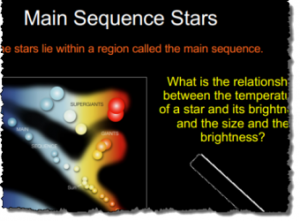Stars change: Difference between revisions
mNo edit summary |
m (subjects, ages, types) |
||
| (3 intermediate revisions by 2 users not shown) | |||
| Line 1: | Line 1: | ||
{{ResourcePageGroupMenu|Astronomy - presentations}} | {{ResourcePageGroupMenu|Astronomy - presentations}} | ||
[[Category:Science]] | [[Category:Science]] | ||
{{Rinfo | {{Rinfo | ||
|type= Lesson idea | |||
|attribution={{Chris Tooley}} | |||
|final= | |final= | ||
|title=Stars change | |title=Stars change | ||
|topic=Astronomy | |topic=Astronomy | ||
|subject=Science | |subject=Science | ||
|tagline= | |tagline=About the stars in the Hertzsprung-Russell diagram and how supernovae form at the end of a star's life | ||
|image= | |image=Starschange1.png | ||
|resourcenumber= SC0040 | |resourcenumber= SC0040 | ||
|Learning Objectives= | |Learning Objectives= | ||
* | * to explain the variety of stars in the Hertzsprung-Russell diagram: main sequence stars / red giants / super giants / white dwarfs | ||
* | * to explain how supernovae form at the end of the stellar lifecycle | ||
|age=Secondary | |age=Secondary | ||
|content= | |content=Students commonly believe that all stars are the same. They also incorrectly believe that stars become progressively larger and brighter until finally becoming red giants. As one of the final presentations in a series, this looks at the nature and origin of different types of star. The teacher has again provided slides and a commentary to help re-create his approach to this topic. | ||
|format= | |format= | ||
|strategy= | |strategy= | ||
| Line 24: | Line 24: | ||
|other= | |other= | ||
|resources= | |resources= | ||
* Smartboard notebook | * Teacher's audio explanation of how the lesson was delivered [[media:CT - Stars change voiceover.MP3]] | ||
* Powerpoint version:[[ ]] | The presentation has been converted to alternative formats: | ||
* PDF | * Smartboard notebook version [[File:SC0040 Stars change.notebook]] | ||
* Powerpoint version:[[File:]] | |||
* PDF version [File:SC0040 Stars change.pdf]] | |||
}} | }} | ||
Latest revision as of 15:48, 28 September 2012
Astronomy - presentations
[[|<<<]]
[[|>>>]]
This resource may not be final.
Lesson idea. Students commonly believe that all stars are the same. They also incorrectly believe that stars become progressively larger and brighter until finally becoming red giants. As one of the final presentations in a series, this looks at the nature and origin of different types of star. The teacher has again provided slides and a commentary to help re-create his approach to this topic.
Teaching approach. The lesson model is that of active note-making. Students must not take notes from the board but instead must use their creativity to develop their own notes. They are encouraged to use colour, image, symbols, humour and metaphor to lead them through a richer learning experience. Students need help in achieving this but soon catch onto the idea. They become more independent with taking notes and more attentive to the subject at hand. The teacher keeps a clear focus to use open rather than closed questioning throughout. (edit)
| Resource details | |
| Title | Stars change |
| Topic | |
| Teaching approach | |
| Learning Objectives |
|
| Format / structure | |
| Subject | |
| Age of students / grade | |
| Table of contents | |
| Additional Resources/material needed | |
| Useful information | |
| Related ORBIT Wiki Resources | |
| Other (e.g. time frame) | |
| Files and resources to view and download |
The presentation has been converted to alternative formats:
|
| Acknowledgement | |
| License | |

